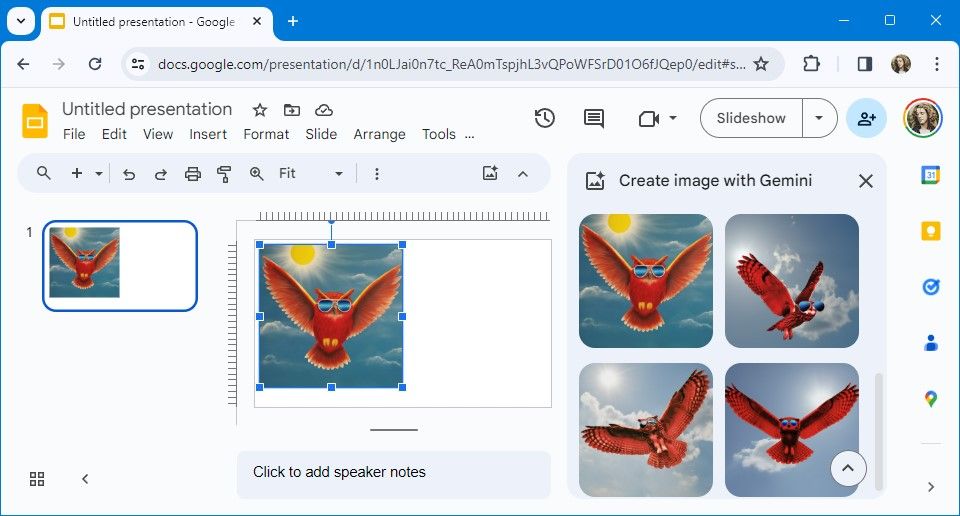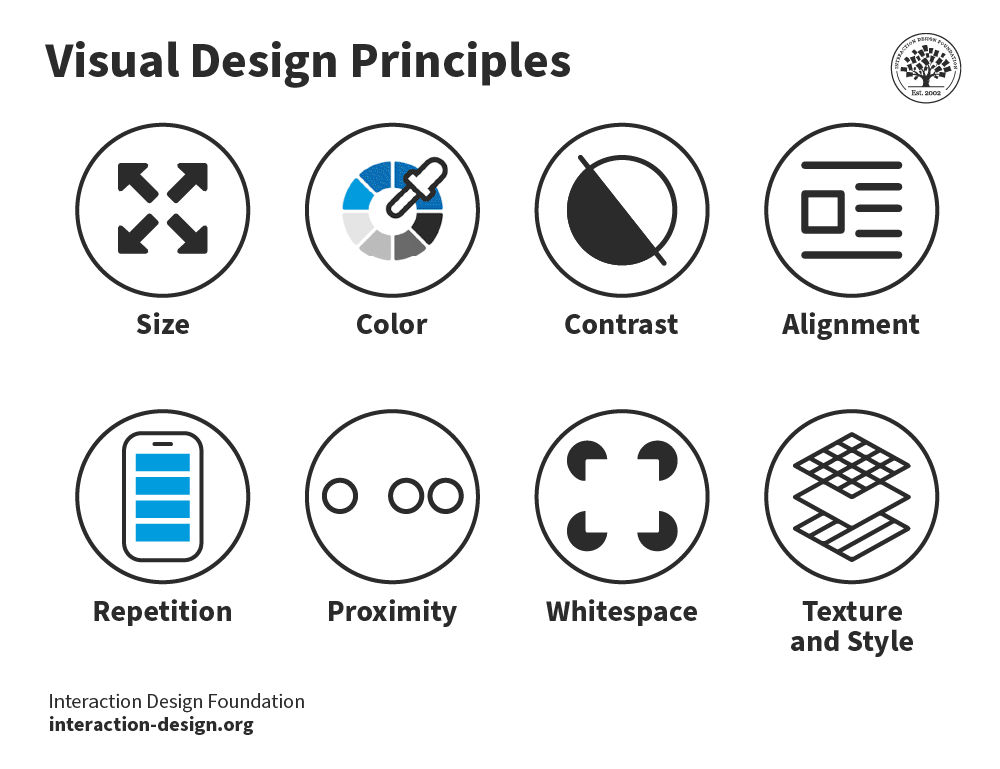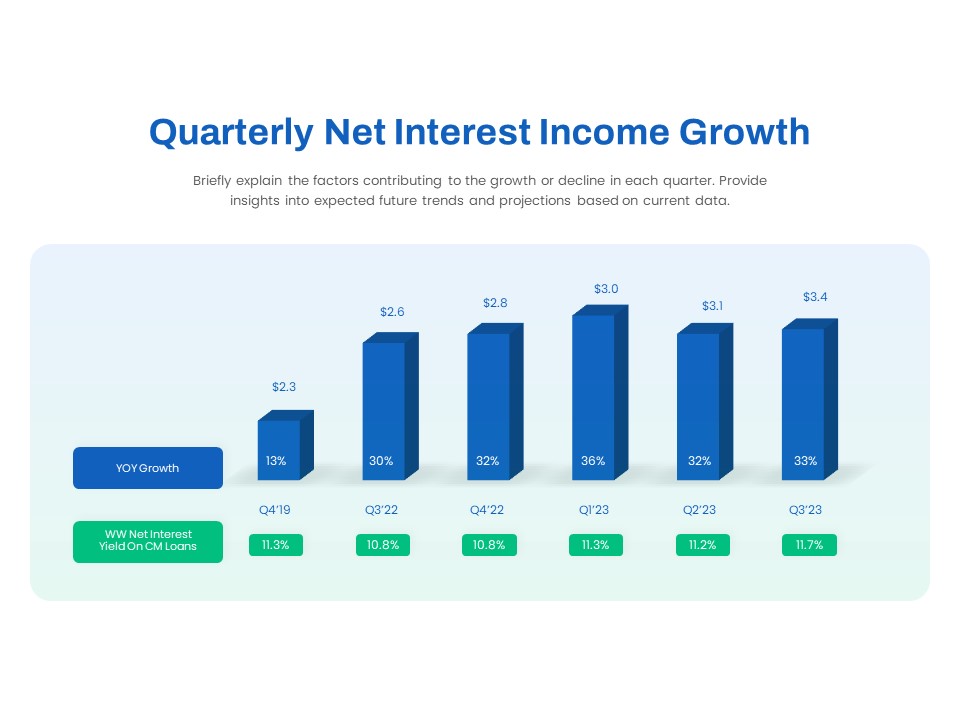Mastering Custom Image Creation with Gemini AI in Google Slides
A Visual Revolution for Your Presentations
Introduction to Gemini AI Image Generation in Google Slides
I've been exploring the integration of Gemini AI with Google Slides, and it's truly revolutionizing how we create presentations. Gemini AI is Google's advanced artificial intelligence assistant that now offers powerful image generation capabilities directly within Google Slides, allowing users to create custom visuals without leaving their presentation environment.

At its core, the "Create an image" or "Help me visualize" functionality allows presenters to generate custom images by simply describing what they want to see. This feature is transforming presentation creation by enabling anyone to produce unique, tailored visuals without graphic design expertise or external tools.
The key benefits I've discovered while using this technology include:
- Significant time savings - No more searching through stock photo sites or creating graphics from scratch
- Unique, customized visuals - Images tailored specifically to your content and message
- Enhanced presentation impact - Professional-looking visuals that engage audiences more effectively
- Accessibility for non-designers - Create impressive visuals without specialized design skills
How Gemini AI Transforms Presentations
The diagram below illustrates how Gemini AI integrates into the presentation creation workflow:
flowchart TD
A[Presentation Concept] --> B[Open Google Slides]
B --> C[Access Gemini AI]
C --> D[Write Image Prompt]
D --> E[Generate Multiple Options]
E --> F[Select & Insert Image]
F --> G[Enhance Presentation]
style C fill:#FF8000,stroke:#333,stroke-width:1px
style D fill:#FF8000,stroke:#333,stroke-width:1px
style E fill:#FF8000,stroke:#333,stroke-width:1px
As we dive deeper into this guide, I'll share my hands-on experience with this powerful tool and provide practical advice for creating stunning presentation visuals with Gemini AI images in Google Slides.
Getting Started with Gemini AI in Google Slides
Before you can start creating custom images with Gemini AI, there are a few setup steps I needed to complete. Let me walk you through the process of getting everything configured properly.
Setting up Gemini in your Google Workspace
First, you'll need to ensure you have the right access and settings enabled:
Prerequisites:
- An eligible Google Workspace account or Google AI plan
- Smart features and personalization settings enabled
- Desktop access (mobile functionality is currently limited)
To enable the required settings, I had to:
- Go to Gmail > Settings > See all settings > General
- Scroll down to find "Smart features and personalization"
- Ensure both checkboxes are selected
- Click "Save Changes" at the bottom of the page

Accessing the Gemini AI Image Generation Feature
Once the setup is complete, accessing the image generation feature is straightforward:
Accessing Gemini in Google Slides
Here's how to find and use the Gemini image generation feature:
flowchart LR
A[Open Google Slides] --> B[Click "Ask Gemini" icon]
B --> C{Select Option}
C -->|Option 1| D["Type 'Create an image'"]
C -->|Option 2| E["Click 'Help me visualize'"]
C -->|Option 3| F["Use custom prompt"]
D --> G[Enter image description]
E --> G
F --> G
G --> H[Review generated images]
style B fill:#FF8000,stroke:#333,stroke-width:1px
style G fill:#FF8000,stroke:#333,stroke-width:1px
You can find the "Ask Gemini" icon in the Google Slides toolbar, typically appearing as a colorful star or sparkle icon. After clicking it, you'll see a sidebar where you can enter your image generation prompts.
Important Note:
This feature is currently available only on desktop browsers. Make sure you're accessing Google Slides from a computer rather than a mobile device for the full functionality.
For users looking to enhance their presentations beyond what's available in Google Slides, AI Google Slides enhancements can provide additional capabilities and integration options.
Crafting Effective Image Prompts for Gemini AI
The quality of images Gemini generates depends significantly on how well you craft your prompts. I've experimented extensively with different prompt styles and have developed some effective strategies.
Fundamental Principles for Clear Image Prompts
When writing prompts for Gemini AI, I follow these core principles:
- Be specific and detailed - The more information you provide, the better the results
- Describe visual elements clearly - Mention colors, styles, composition, and mood
- Provide context - Explain how the image will be used in your presentation
- Specify artistic style - Indicate whether you want photorealistic, cartoon, minimalist, etc.
Elements of an Effective Prompt:
Examples of Effective vs. Ineffective Prompts
❌ Ineffective Prompt:
"Make me a business chart"
Too vague, lacks specifics on type of data, style, or purpose.
✅ Effective Prompt:
"Create a clean, minimalist bar chart showing growth trends for a tech startup, using a blue and orange color scheme with 5 data points and an upward trajectory"
Specific, detailed, includes style, colors, and purpose.
❌ Ineffective Prompt:
"Make an image about teamwork"
Too general, doesn't specify style or context.
✅ Effective Prompt:
"Create a professional illustration of diverse team members collaborating around a conference table, with warm lighting, modern office setting, and subtle infographic elements showing team productivity, in a flat design style with teal and coral accents"
Detailed, specifies style, setting, elements, and color scheme.
Advanced Prompting for Presentation Contexts
For presentations specifically, I've found these advanced techniques particularly useful:
- Specify slide purpose - "Create an image for an opening slide that introduces a cybersecurity concept"
- Request negative space - "Include empty space on the left side where I can add bullet points"
- Mention audience - "Design for a technical audience with detailed data visualization elements"
- Request data visualization - "Create a visual representation of a customer journey with 4 stages and icons for each step"

For those interested in exploring more advanced image generation capabilities, create images using google ai generator provides additional techniques and examples beyond what's available in Google Slides.
Step-by-Step Image Generation Workflow
Now that we understand how to craft effective prompts, let's walk through the complete process of generating and implementing images in your Google Slides presentations.
Complete Image Generation Process
Follow these steps to create and implement custom images:
flowchart TD
A[Open slide where image is needed] --> B[Click "Ask Gemini" icon]
B --> C[Enter image prompt]
C --> D[Wait for generation]
D --> E[Review 4 generated options]
E --> F{Satisfied with results?}
F -->|Yes| G[Hover over preferred image]
F -->|No| H[Refine prompt]
H --> C
G --> I[Click "Insert" button]
I --> J[Adjust size and position]
J --> K[Add any additional elements]
style C fill:#FF8000,stroke:#333,stroke-width:1px
style E fill:#FF8000,stroke:#333,stroke-width:1px
style G fill:#FF8000,stroke:#333,stroke-width:1px
Detailed Walkthrough
-
Open Google Slides and navigate to your target slide
First, I open my presentation and go to the specific slide where I want to add a custom image.
-
Access Gemini AI
I click on the "Ask Gemini" icon in the toolbar (it looks like a colorful star or sparkle).
-
Enter your image prompt
In the sidebar that appears, I type my detailed image prompt following the principles we discussed earlier.
-
Review generated options
Gemini typically generates four different image options based on my prompt. I take time to review each one carefully.
-
Select and insert your preferred image
When I hover over my preferred image, an "Insert" button appears. I click this button to add the image directly to my slide.
-
Adjust and position the image
After insertion, I can resize, crop, and position the image just like any other image in Google Slides.

Troubleshooting Common Issues
When Gemini Can't Fulfill Your Request
I've encountered several situations where Gemini couldn't generate the requested image. Here's how I handle those scenarios:
- Content policy violations - Rephrase your request to avoid potentially sensitive or restricted content
- Overly complex requests - Break down your request into simpler components
- Technical limitations - Try a different approach or style for the same concept
- Ambiguous prompts - Add more specific details about what you want to see
Common Reasons for Generation Failure
After creating your custom images, you might want to use them in other contexts. Learning how to save image from Google Slides can help you repurpose these visuals for other materials.
Enhancing Presentations with Strategic AI-Generated Visuals
Creating individual images is just the beginning. I've found that the real power of Gemini AI comes from strategically using these visuals to enhance the overall presentation experience.
Creating Cohesive Visual Themes
One of the most effective strategies I've discovered is creating a consistent visual language throughout your presentation:

- Consistent color palette - Specify the same color scheme in all your image prompts
- Unified artistic style - Maintain the same visual style (e.g., flat design, isometric, watercolor)
- Recurring visual elements - Include similar motifs or symbols across different slides
- Progressive visual storytelling - Create images that build upon each other as your presentation progresses
Balancing Text and AI-Generated Imagery
Finding the right balance between text and visuals is crucial for effective presentations:
Complementary Approach
Images should enhance and illustrate your text points, not merely repeat them.
- Use visuals to explain complex concepts
- Let images evoke emotional responses
- Create visual metaphors for abstract ideas
Layout Strategies
Consider how text and images will interact on your slides.
- Request images with space for text overlay
- Use split-screen layouts (text on one side, image on the other)
- Consider minimalist images for text-heavy slides
Visualizing Complex Concepts and Data
One of the most powerful applications I've found for Gemini AI is creating visuals that explain complex ideas:
Transforming Concepts into Visuals
How abstract concepts can be visualized with Gemini AI:
flowchart LR
A[Abstract Concept] --> B{Visualization Strategy}
B -->|Metaphorical| C[Visual Metaphor]
B -->|Data-Driven| D[Infographic/Chart]
B -->|Process-Based| E[Step-by-Step Visual]
B -->|Comparative| F[Side-by-Side Imagery]
C --> G[Gemini Prompt]
D --> G
E --> G
F --> G
G --> H[Custom Visual]
style A fill:#FFE5CC,stroke:#333,stroke-width:1px
style G fill:#FF8000,stroke:#333,stroke-width:1px
style H fill:#FFB366,stroke:#333,stroke-width:1px
Examples of complex visualizations I've successfully created with Gemini include:
- Data flow diagrams - Showing how information moves through systems
- Concept maps - Illustrating relationships between ideas
- Process visualizations - Depicting step-by-step workflows
- Comparative illustrations - Showing before/after or different approaches side-by-side
For those looking to combine the power of multiple tools, learning how to add Google Slides to Canva can provide additional design flexibility and options for your presentations.
Customization and Refinement Techniques
While Gemini AI generates impressive images, I've found that applying additional customization can take these visuals to the next level and make them perfectly suited to your presentation needs.
Post-Generation Image Editing
After inserting a Gemini-generated image, I often apply these editing techniques within Google Slides:
Cropping & Resizing
- Focus on key elements
- Adjust aspect ratio
- Create consistent image sizes
Adjusting Transparency
- Fade images for text overlay
- Create watermark effects
- Layer multiple images
Adding Effects
- Apply shadows for depth
- Add borders for emphasis
- Use reflection for polish
Iterative Prompt Refinement
If my first attempt doesn't yield the perfect image, I use these iterative refinement strategies:
Prompt Refinement Process
How I improve prompts based on initial results:
flowchart TD
A[Initial Prompt] --> B[Review Results]
B --> C{Identify Issues}
C -->|Style Problems| D[Add style descriptors]
C -->|Content Missing| E[Specify missing elements]
C -->|Wrong Mood| F[Add mood/tone words]
C -->|Wrong Colors| G[Specify exact colors]
D --> H[Refined Prompt]
E --> H
F --> H
G --> H
H --> I[Improved Results]
style A fill:#FFE5CC,stroke:#333,stroke-width:1px
style C fill:#FF8000,stroke:#333,stroke-width:1px
style H fill:#FFB366,stroke:#333,stroke-width:1px
Pro Tip:
Keep a "prompt journal" of successful prompts for different types of visuals. I've found this tremendously helpful for quickly creating consistent imagery across multiple presentations.
Creating Composite Visuals
For more complex visual needs, I sometimes combine multiple Gemini-generated images:
- Layering technique - Generate background and foreground elements separately, then combine
- Split-screen approach - Create multiple images and arrange them in a grid or sequence
- Element collection - Generate individual icons or elements and arrange them into a custom layout
- Background enhancement - Use one image as a background and overlay text or other elements

Effectiveness of Different Customization Techniques
Best Practices and Ethical Considerations
As I've integrated Gemini AI into my presentation workflow, I've developed a set of best practices and ethical guidelines that help ensure appropriate and effective use of this powerful tool.
Guidelines for Appropriate Use
When using AI-generated imagery in professional contexts, I follow these guidelines:
- Respect content policies - Avoid generating images that could be inappropriate, offensive, or violate Google's content policies
- Verify accuracy - Ensure that any data visualizations or factual representations are accurate and not misleading
- Consider audience sensitivities - Be mindful of cultural, social, and professional contexts when creating images
- Avoid copyright issues - Don't request specific copyrighted characters, logos, or designs

Attribution and Disclosure
In professional settings, I consider these attribution practices:
When to Disclose AI Generation
- Academic or educational presentations
- When presenting to clients who may assume custom design work
- In contexts where image provenance matters
- When organizational policies require disclosure
Attribution Methods
- Simple footer note: "Images: Google Gemini AI"
- Credits slide at the end of presentation
- Verbal acknowledgment during presentation
- Notes in shared presentation files
Providing Feedback to Improve Gemini
I actively contribute to improving the system through feedback:
- Report inaccurate results - Help train the system by reporting when outputs are factually incorrect
- Flag problematic content - If Gemini generates inappropriate content, use the feedback mechanisms to report it
- Submit feature suggestions - Use Google's feedback channels to suggest improvements
How to Submit Feedback:
To provide feedback on Gemini's image generation, go to Help > Help Slides improve from the top menu in Google Slides. For legal issues, you can create a specific request through Google's support channels.
Ethical Considerations by Context
Advanced Applications and Integration Strategies
As I've become more proficient with Gemini AI in Google Slides, I've discovered several advanced techniques that take presentation creation to new heights.
Combining Multiple AI Features
The most powerful approach I've found is integrating multiple Gemini capabilities:
Integrated AI Workflow
How different Gemini features can work together:
flowchart TD
A[Presentation Topic] --> B[Help me create slide content]
A --> C[Help me visualize imagery]
B --> D[AI-generated text content]
C --> E[AI-generated visuals]
D --> F[Complete Slide]
E --> F
F --> G[Help me summarize]
G --> H[Presentation summary]
style B fill:#FF8000,stroke:#333,stroke-width:1px
style C fill:#FF8000,stroke:#333,stroke-width:1px
style G fill:#FF8000,stroke:#333,stroke-width:1px
Integration strategies I've found effective include:
- Content-first approach - Generate slide text content first, then request visuals that complement it
- Visual-first approach - Create impactful images first, then ask Gemini to generate text that explains them
- Iterative refinement - Use Gemini's feedback and suggestions to improve both text and visuals
- Complete slide generation - For some slides, have Gemini create both content and visuals simultaneously
Workflow Optimization for Image-Heavy Presentations
For presentations requiring numerous custom visuals, I use these efficiency strategies:
Batch Creation Process
- Theme development - Create a visual style guide with color palette, style preferences, and visual motifs
- Template prompts - Develop reusable prompt templates that maintain consistency
- Systematic generation - Generate all similar images (e.g., all section headers) in one session
- Organized storage - Save generated images in a dedicated folder for reuse across presentations
- Style reference images - Keep successful images as reference points for future prompts
Time Savings with Batch Creation
Extending AI-Generated Visuals Beyond Slides
I've found numerous ways to leverage these custom visuals beyond just the presentation:
- Export for social media - Use key visuals for social posts about your presentation
- Include in reports - Export and incorporate images into related documents
- Create handouts - Use visuals in printed materials that accompany your presentation
- Build visual libraries - Develop a collection of custom imagery for consistent brand communication

Case Studies and Inspiration Gallery
To illustrate the transformative potential of Gemini AI for presentations, I've collected several real-world examples that showcase impressive before-and-after scenarios.
Presentation Transformations
Case Study 1: Technical Presentation
A software architecture presentation transformed from text-heavy slides to visual architecture diagrams.

Prompt used: "Create a clean, modern software architecture diagram showing microservices communication with API gateway, using blue and orange color scheme with clear data flow indicators"
Case Study 2: Marketing Presentation
A product launch presentation enhanced with custom illustrations of the customer journey.

Prompt used: "Create a visually engaging customer journey map with 5 stages from awareness to advocacy, using friendly illustrations, warm colors, and emotion indicators at each stage"
Case Study 3: Educational Presentation
A biology lecture enhanced with custom anatomical illustrations.

Prompt used: "Create a detailed but clear illustration of a human cell showing major organelles with labels, using a cross-section view with bright colors against a light background"
Case Study 4: Business Strategy
A quarterly business review transformed with data visualizations and trend illustrations.

Prompt used: "Create a professional business growth visualization showing quarterly trends with an upward trajectory, incorporating subtle infographic elements and a corporate blue color palette"
Industry-Specific Applications
I've observed how different industries are leveraging Gemini AI for specialized presentation needs:
Industry-Specific Image Generation Usage

Key industry applications I've observed include:
- Healthcare - Anatomical illustrations, patient journey maps, and treatment visualizations
- Finance - Market trend visualizations, investment concept illustrations, and risk assessment graphics
- Education - Concept illustrations, historical recreations, and scientific diagrams
- Marketing - Customer personas, brand story illustrations, and product benefit visualizations
- Technology - System architecture diagrams, workflow illustrations, and concept visualizations
Future Developments and Alternatives
As Gemini AI continues to evolve, I'm keeping a close eye on upcoming features and also exploring complementary tools that can enhance my visual presentation capabilities.
Upcoming Gemini Features
Based on Google's development patterns and industry trends, we can anticipate these potential enhancements:
Potential Gemini Evolution
Expected feature development roadmap:
timeline
title Anticipated Gemini AI Feature Evolution
section Short-term
Enhanced style control : Finer control over visual styles
Animation support : Simple animated elements
section Mid-term
Multi-slide themes : Consistent visuals across presentations
Custom branding : Incorporate brand elements
section Long-term
Interactive elements : Clickable image components
3D visualization : Three-dimensional image generation
Video generation : Brief animated sequences
Comparison with Alternative Tools
While Gemini AI offers impressive capabilities, I've also explored how it compares to other visual creation tools:
| Feature | Gemini AI | Dedicated AI Image Tools | Traditional Design Software | PageOn.ai |
|---|---|---|---|---|
| Ease of Use | ★★★★★ | ★★★☆☆ | ★★☆☆☆ | ★★★★★ |
| Integration with Presentations | ★★★★★ | ★★☆☆☆ | ★★★☆☆ | ★★★★☆ |
| Image Quality | ★★★★☆ | ★★★★★ | ★★★★★ | ★★★★★ |
| Customization Options | ★★★☆☆ | ★★★★☆ | ★★★★★ | ★★★★★ |
| Speed/Efficiency | ★★★★★ | ★★★☆☆ | ★★☆☆☆ | ★★★★☆ |
| Visual Storytelling | ★★★☆☆ | ★★★☆☆ | ★★★★☆ | ★★★★★ |
PageOn.ai: Enhanced Visual Storytelling
While exploring alternatives, I've been particularly impressed with how PageOn.ai complements and extends Gemini's capabilities:
Seamless Integration
PageOn.ai excels at integrating multiple visual elements into cohesive narratives, allowing for more sophisticated visual storytelling than what's possible with Gemini alone.
Intuitive Content Blocks
The platform's intuitive content block arrangement makes it easy to create complex visual presentations with multiple interconnected elements.
Advanced Asset Integration
PageOn.ai's deep search capabilities make finding and integrating the perfect visual assets much more efficient than manual searches.

Creating a Complementary Workflow
I've found that the most powerful approach is combining multiple tools in a strategic workflow:
- Initial concept development - Use Gemini AI to quickly generate visual concepts
- Visual refinement - Enhance selected images with more specialized tools if needed
- Narrative integration - Use PageOn.ai to create cohesive visual narratives across multiple slides
- Presentation assembly - Combine the best elements into your final Google Slides presentation
- Cross-platform distribution - Leverage the visuals across multiple channels and formats
Optimal Multi-Tool Workflow
How different tools can work together:
flowchart LR
A[Presentation Concept] --> B[Gemini AI]
B -->|Initial Visuals| C[PageOn.ai]
C -->|Enhanced Storytelling| D[Google Slides]
B -->|Direct Integration| D
D --> E[Final Presentation]
style B fill:#FF8000,stroke:#333,stroke-width:1px
style C fill:#42A5F5,stroke:#333,stroke-width:1px
Transform Your Visual Expressions with PageOn.ai
Take your presentations beyond Gemini's capabilities with PageOn.ai's advanced visual storytelling tools, intuitive content blocks, and seamless asset integration.
Start Creating with PageOn.ai TodayFinal Thoughts
Throughout this guide, I've shared my experience with creating custom images using Gemini AI in Google Slides. This technology has fundamentally changed how I approach presentation design, making it possible to create professional, custom visuals without specialized design skills.
As we've explored, the key to success lies in crafting effective prompts, understanding the workflow, and applying strategic customization techniques. While Gemini AI offers impressive capabilities directly within Google Slides, complementing it with specialized tools like PageOn.ai can take your visual storytelling to even greater heights.
I encourage you to experiment with these techniques in your own presentations. Start with simple image requests, refine your prompt-writing skills, and gradually incorporate more advanced strategies. The more you practice, the more intuitive and powerful this approach becomes.
Remember that the goal isn't just to create pretty pictures—it's to enhance understanding, engagement, and retention of your message. When used thoughtfully, AI-generated visuals can transform your presentations from ordinary to extraordinary, helping you communicate more effectively and leave a lasting impression on your audience.
You Might Also Like
Beyond "Today I'm Going to Talk About": Creating Memorable Presentation Openings
Transform your presentation openings from forgettable to captivating. Learn psychological techniques, avoid common pitfalls, and discover high-impact alternatives to the 'Today I'm going to talk about' trap.
Transform Raw Text Data into Compelling Charts: AI-Powered Data Visualization | PageOn.ai
Discover how AI is revolutionizing data visualization by automatically creating professional charts from raw text data. Learn best practices and real-world applications with PageOn.ai.
The Art of Instant Connection: Crafting Opening Strategies That Captivate Any Audience
Discover powerful opening strategies that create instant audience connection. Learn visual storytelling, interactive techniques, and data visualization methods to captivate any audience from the start.
Mastering Workplace Communication with International Phonetic Alphabet (IPA) - Visual Guide
Discover how the International Phonetic Alphabet transforms workplace communication. Learn visual approaches to implement IPA for clearer global business interactions.
